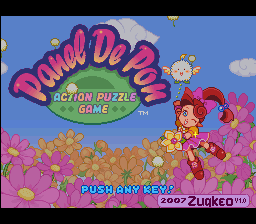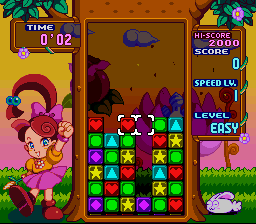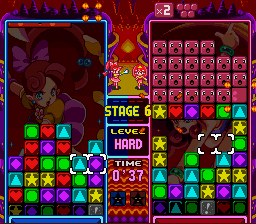Forum Links
Thread Information
Thread Actions
Magical Panels
08-24-11 06:12 PM
 Someone70 is Offline
| ID: 447460 | 2415 Words
Someone70 is Offline
| ID: 447460 | 2415 Words
 Someone70 is Offline
Someone70 is Offline

POSTS: 2429/8111
POST EXP: 305427
LVL EXP: 53055300
CP: 5028.4
VIZ: 29251

What happens when you combine 10-year-old magical girls, lightning fast puzzle mechanics, and addictive gameplay? You get Panel de Pon! The game was originally released in 1995 for the Japan-only console of the Super Famicom. Since then, it has grown to a game series known as the Panel de Pon series in Japan and the Tetris Attack or Puzzle League series in Europe and North America. Many people will recognize the game and its similarities to Pokemon Puzzle League, one of the most well known games in the Puzzle League series. Panel de Pon was quite the pioneer for its time, but the game play it provides for the Super Famicom remains challenging and fun today.
The basic concept behind the puzzle game is matching colors in rows or columns. You have a cursor on the screen that looks like two boxes put side-by-side. When you press A, the blocks in those boxes switch positions. Your goal is to put together three or more of the same colored boxes to clear them. Putting together more than three is called a combo and clearing blocks right after another is called a chain. When these two are put together, you can rack up a lot of points in endless mode or defeat your opponent quickly in VS mode.
Graphics: 7
Because Panel de Pon is a puzzle game, it doesn’t require the best graphics. The most important work goes into the puzzle blocks, which are just colored squares containing stars, hearts, circles, etc, in order to differentiate among them. Fortunately, this simplistic design won’t distract you from the main part of the game: actually clearing the blocks.
In all, there are 9 playable characters (6 in anything but VS), though the character you choose doesn’t affect your gameplay a whole lot. Each character represents a cute little fairy of a different element. For instance, Lip is the fairy of flowers. When you select her as your character, you will see a picture of her in the background and your garbage blocks will be red to represent Lip. The most detail in the game is put into the character sprites, though in total they have 10-15 frames each.
In endless mode, you play and rack up points until the blocks hit the top. The character that you select will determine what the surroundings of your play field will look like. The fairy of nature, Thiana, has a calm forest background as you play with forest creatures running around as you make combos and chains.
In VS mode, you send garbage blocks to your opponent by making combos or chains in order to make them hit the top of the play area before you do. These funny looking blocks are giant rectangles that plop down on your nicely colored field. What’s more is that each block mocks you with a
There are few complaints to be described with the games graphics. However, it doesn’t do many new things and especially doesn’t compare to the graphics and animations of, say, Super Mario World.
Music (Sound): 9
Along with a unique graphic with each character you choose, each fairy also has her own theme that plays during the game. The music that plays on each character’s stage is also a reflection of her personality. This can personalize your game because your favorite character to use will be the
Additionally, the creators spice things up a little by including a “danger” theme for each character when your blocks are getting close to the top. Each of these sounds similar to its respective characters’ theme, but it has a different melody and it’s faster, giving a feeling of
The developers added a few more sounds here and there to further increase the enjoyability of the game. Each character has a catchphrase that they’ll say whenever you get a combo or a chain. For example, Lip says “Ikuzo!” (“Let’s go!” in Japanese) whenever you get a combo or chain. The voice acting is quite cute, and gives a little more incentive for scoring more combos. Additionally, when you score a chain of 4 or greater, a fanfare plays at the end of it in order to mark your accomplishment. The fanfare that plays at a 4 chain is basic, but the combo that plays at the end of a 6 chain is rich and fulfilling. This also helps to alert your opponent that a ton of pain is on its way.
Addictiveness: 10
The reason why a game like Panel de Pon is so addicting is the same reason why people can play Tetris for hours and hours on end. In fact, Panel de Pon was named Tetris Attack for its North American release. Even though the concept itself has little to do
Every time you play Panel de Pon, the experience changes. The blocks hardly repeat, so in every new game, you must formulate a strategy in order to clear the blocks in the most efficient way and while getting the most points you can. Like a Rubik’s cube, there are some strategies that you can keep in mind before you start the game, but nothing is set in stone until you start playing. There is also the Time Trial mode in which you have to get as many points as possible within 2 minutes. Like in Endless mode, you don’t know what kind of blocks you’re going to get. In some cases, you’ll get lucky and spot patterns right away. In other cases, you’ll be struggling to find something and won’t score as many points that round. It’s the fact that Time Trial is so short, yet has the potential for so many points, that makes you want to keep attempting it over and over again. In the VS mode, computer will also not get the same blocks every time. Each new encounter with the CPU presents a unique challenge in itself. Sometimes, you’ll be able to beat it in a matter of a mere few seconds, while other times, you’ll find yourself slugging it out until minutes pass (and that’s a long time in a game like this one) and end up losing at the last second. It’s the fact that you don’t know how the CPU will react that VS mode is so fun to play over and over again.
Story: 6 Sadly, the story of Panel de Pon did not get as much consideration as the rest of the game. It could have been expanded on, but that would detract players from the main point of the game, and that would be the puzzle aspect of it. In Puzzle de Pon, the land that Lip and her friends live in, Poppos, is being threatened by an evil kind named Thanatos. He casts an evil spell over the land that makes it so that all the fairies fight bitterly with each other! Fortunately, Lip isn’t
Along the way, you’ll meet many of your fairy friends that have been turned into fighting machines. After facing off in a puzzle duel with them (and winning of course), they revert back into their normal, friendly personalities and join Lip in her quest for justice. When all of her friends have been rescued, they proceed to defeat the monsters and source of the terrible spell: Thanatos.
However, when you beat Thanatos, a new challenger appears, a goddess named Cordelia. Once you finally beat her in a battle, the world reverts back to normal and all is well again. Cordelia reveals herself as (spoiler) Lip’s mother and tells her that the monsters were just an illusion. When asked why, Lip’s mother, who is also the queen of the land, responds that it was a test in order to prepare Lip for her succession to the throne. Then Lip’s friends cheer for her, Lip is overjoyed, and all is well in Poppos. So as you can see, the story isn’t great. It’s just a mere plot device to get you to fight all the fairies in magical puzzle games. At least it works in introducing the characters and you fight the fairies anyways. Depth: 9 For a puzzle game on the SNES, Panel de Pon is full of different things you can do. As mentioned before, there are endless, time trial, and VS modes in the games. Two modes that have not been mentioned yet are Stage Clear and Puzzle. Lip and her friends will also join you in these modes, although there is no story to back them up. In Stage Clear mode, you have to clear lines of blocks until you get them all below the “clear line.” This line will not show up at first; you have to keep clearing and pushing up blocks until you get it to show. The trick to Stage Clear mode is to beat the levels as quickly as possible. The longer you take, the higher the speed will increase, which makes subsequent rows of blocks come up faster. If that number gets too high, you’ll find yourself to be overwhelmed by blocks and they’ll soon hit the top. So in order to avoid that, you must get them below the clear line as soon as you have the chance. Puzzle mode is a unique twist on something that is already considered to be a puzzle game. In this mode, you are given a set arrangement of blocks. No blocks will come up from below, so you don’t have to worry about being pressured to clearing as fast as you can. Along with the set of blocks, you get a number counter. This number represents how many moves you can make in the puzzle. The object of the mode is to clear all the blocks off the screen without exceeding the number of moves that you’re given. These kinds of puzzles require a lot more slow thinking time than the main game would. It’s provides something different for those that like relaxing and slow-paced puzzle games.
There are also two player modes that you can play with a friend. The game also provides some video hints that you can study in order to get better at Panel de Pon. These videos demonstrate some useful hints and tricks that you normally wouldn’t think of when playing the game. Even without these extra modes, Panel de Pon has a deep underlying structure beneath its gameplay. There are many small and discreet hints that you can implement to better your game. For instance, when you’re clearing garbage blocks, you can set up the blocks so that the cleared ones fall right down and make an immediate chain. In this way, you can send the full package right back at your opponent, possibly with an ever bigger supply. Difficulty: 7 Panel de Pon is one of those puzzle games that’s easy to learn and difficult to master. To the first-time player, the concept of switching blocks is fairly simple, and finding a way to match 3 in a row comes within minutes. However, it takes a lot more practice and many more hours of gameplay to know the different arrangements that one can use to make the best combos and chains. It’s perfectly natural on games like these for the beginning player to struggle achieving more points. The various modes in the game also have their adjustable difficulty settings, ranging from Easy to Hard. Each difficulty has a different number of types of blocks (more types means less chance for matches) and different timing for chains. On Hard, your timing for skill chains has to be more precise than on Easy. In VS mode, a Hard CPU will think faster and smarter than an Easy CPU. You’ll find that your matches will last much longer on Hard than on Easy.
For those of you that are used to the physics on Pokemon Puzzle League, Panel de Pon requires a better hand and more thinking ahead. The break between clearing blocks and the time they fall is much shorter, so it’s even more important that you know what you’re doing before starting to clear a chain. Final Score: 9.1 Overall, Panel de Pon is one of the most addicting fast-paced puzzle games out there. It’s no wonder that it was popular enough to be released under the name of Tetris Attack. Not only are the characters cute and the music fitting to listen to, but the many modes that the game contains make great and creative use of the basic gameplay. For a unique and addicting game that puzzle lovers will play as much as Tetris, Panel de Pon provides everything you need for a wonderful puzzle experience. Although Panel de Pon was originally a Japan-only release for Super Famicom, some wonderful people translated the game into English. This version you can play in the RGR, so you won't have to worry about not understand how to play the game. Though in a game like this, you don't have to read much anyways...
|
| #1 Touhou fan!| Nitori Kawashiro |
Affected by 'Laziness Syndrome'
Registered: 06-02-11
Last Post: 3394 days
Last Active: 3305 days


 User Notice
User Notice 



















